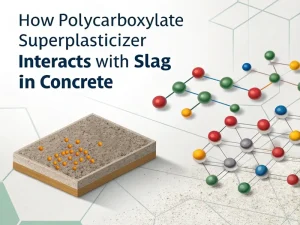Blog

Water reducing admixtures are essential components in modern concrete production, completely changing the way we improve concrete performance. As a concrete admixture, they play a crucial role in improving the workability, strength, and durability of concrete while optimizing the use of water in concrete mixtures.
Water reducing admixtures is a concrete admixture that can reduce the water used in mixing while maintaining the essential consistency of concrete slump. To understand how water-reducing agents work, we first need to understand their performance.
The water reduction rate is a key indicator for measuring the performance of water reducing admixtures, usually requiring a water reduction rate between 15% and 25%. Some high-performance water-reducing agents, such as polycarboxylate superplasticizers, can even achieve a water reduction rate of over 25%. The level of water reduction rate directly affects the water consumption, workability, and strength of concrete.
Water reducing admixtures can significantly increase concrete slump, generally by 10cm~20cm, thereby improving the workability of concrete and facilitating construction. In addition, high-efficiency water-reducing agents can also reduce the bleeding rate and improve the anti-segregation properties of concrete
Concrete mixed with water-reducing agents has higher compressive, flexural, and tensile strength. For example, polycarboxylate superplasticizers can significantly improve concrete’s compressive strength, flexural strength, and freeze-thaw resistance.
Water reducing admixtures can improve the impermeability, carbonation resistance, and chloride ion erosion resistance of concrete, thereby extending its service life. In cold regions, freeze-thaw resistance is an essential indicator for measuring the durability of concrete. High-efficiency water-reducing agents can significantly improve the freeze-thaw resistance of concrete and prevent it from being damaged due to freeze-thaw cycles.
The core function of water reducing admixtures is their ability to disperse cement particles. Cement is a key component of concrete, and during drying, its particles tend to aggregate together due to natural forces such as van der Waals forces. When water is added to cement to form a paste, they clump together.
Water reducing admixtures are usually composed of surface-active substances designed to break down these clumps. They adsorb onto the surface of cement particles, giving them a negative charge. Due to the mutual repulsion of particles with the same charge, cement particles are uniformly dispersed in water.
For example, Polycarboxylate Superplasticizer have a unique molecular structure, and their side groups can effectively adsorb on the surface of cement. This dispersion allows cement particles to be more evenly distributed in the mixture, which is the foundation for achieving uniform and machinable concrete.
One of the most significant effects of water reducing admixtures is lowering the water-to-cement ratio. Traditional concrete mixtures require a certain amount of water to ensure workability, making the concrete easy to mix, pour, and compact. However, excessive water can lead to problems such as decreased strength and increased porosity.
By effectively dispersing cement particles, water-reducing agents can use less water while maintaining or even improving workability. A lower water-cement ratio means less water can evaporate during solidification. Therefore, the concrete matrix becomes denser and has fewer voids. This denser structure not only enhances the strength of concrete but also improves its durability.
For example, reducing the water-cement ratio from 0.5 to 0.4 can lead to a significant increase in the compressive strength of concrete over time.
Water reducing admixtures also impact the hydration kinetics of cement. Hydration is a chemical reaction between cement and water that causes concrete to harden. Depending on the chemical composition of the water-reducing agents, these additives can accelerate or delay the hydration process.
Some water-reducing agents, such as those with certain chemical functional groups, can interact with cement minerals to promote early hydration reactions. This is beneficial in applications where early strength development is crucial, such as precast concrete components or tight construction schedules. On the other hand, other types of water-reducing agents may slow down the hydration process.
This is very useful in pouring large volumes of concrete, such as in dam construction, where it is necessary to control the heat generated by rapid hydration to prevent thermal cracking. Heat is released more slowly by slowing down hydration, reducing the risk of internal temperature differences that may cause cracks.
Processability is a key characteristic of concrete, determining its workability during construction. Water-reducing agents improve workability in various ways. Firstly, as mentioned earlier, dispersing cement particles can produce a more flowing and uniform mixture. This allows concrete to flow freely into the formwork, surrounding steel bars, and narrow spaces.
Secondly, water reducing admixtures can reduce the friction between aggregate particles and cement slurry. Aggregates are coarse and fine materials in concrete mixtures, such as sand and gravel. When the friction between these particles and the cement slurry decreases, the concrete becomes more elastic and easier to handle. This is particularly important in applications requiring long-distance concrete pumping or pouring concrete in complex forms.
For example, in high-rise buildings, concrete is pumped to a high height, and water-reducing agents can ensure that the concrete remains usable throughout the pumping process.
Over time, the effect of water-reducing agents can lead to changes in concrete microstructure. Reduced water-cement ratio and improved cement particle dispersion result in a finer and more uniform microstructure. As the voids decrease and shrink, concrete becomes more impermeable. This is particularly important for durability as it reduces the entry of harmful substances such as water, chlorides, and sulfates.
In addition, well-distributed cement hydration products form a more substantial and continuous matrix around the aggregate particles. The enhanced bond between cement slurry and aggregate helps improve concrete’s overall strength and toughness. For example, in concrete structures exposed to harsh environmental conditions, such as those in marine environments, the use of water-reducing agents can significantly improve the corrosion and degradation resistance of concrete.

How Polycarboxylate Polyether Monomer Affect Concrete Performance
Blog How Polycarboxylate

How Polycarboxylate Superplasticizer Interacts With Slag In Concrete
Blog How Polycarboxylate